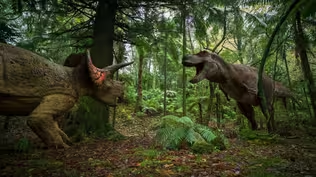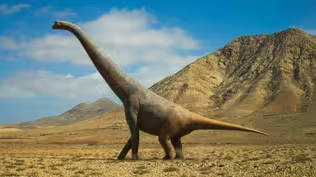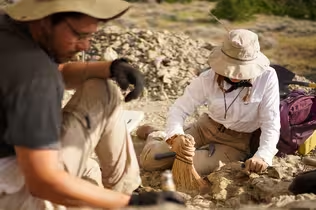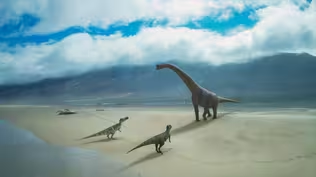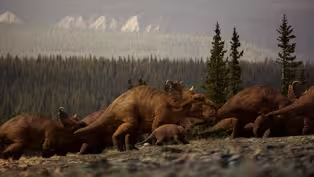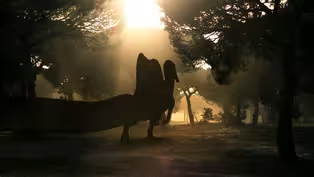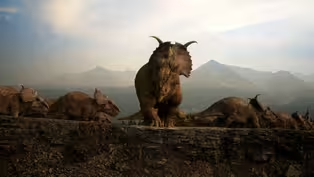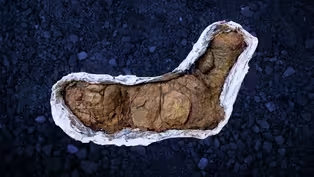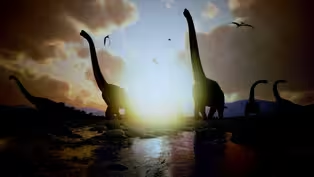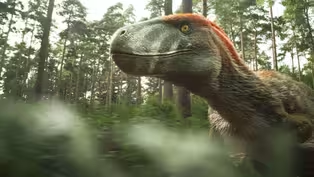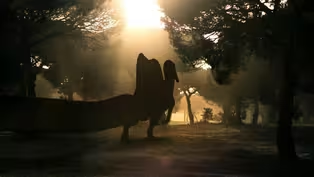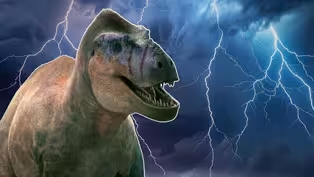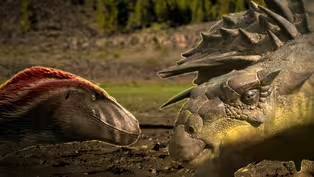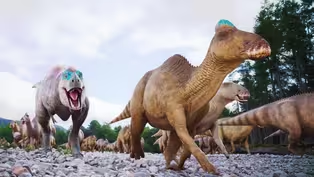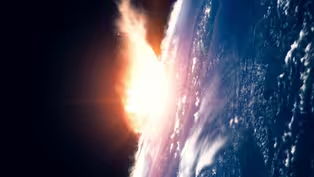
The Dinosaurs that Could Cross the Atlantic
Special | 5m 42sVideo has Closed Captions
How did dinosaur fossils get there?
Dinosaur fossils that appear to belong to the same species have been found on different continents, separated by thousands of miles of ocean. It raises the question - how did they get there? For scientists in Portugal, digging deeper into the mystery has revealed a remarkable solution. Did a time exist when dinosaurs could simply walk from America to Europe?
Problems playing video? | Closed Captioning Feedback
Problems playing video? | Closed Captioning Feedback
Narrator: Bertie Carvel With Thanks: With Thanks: Universidad Nacional de Educación a Distancia, Instituto Dom Luiz, Museu Nacional de História Natural e Da Ciência, Universidad Complutense De Madrid, Faculdade de...

The Dinosaurs that Could Cross the Atlantic
Special | 5m 42sVideo has Closed Captions
Dinosaur fossils that appear to belong to the same species have been found on different continents, separated by thousands of miles of ocean. It raises the question - how did they get there? For scientists in Portugal, digging deeper into the mystery has revealed a remarkable solution. Did a time exist when dinosaurs could simply walk from America to Europe?
Problems playing video? | Closed Captioning Feedback
How to Watch Walking with Dinosaurs
Walking with Dinosaurs is available to stream on pbs.org and the free PBS App, available on iPhone, Apple TV, Android TV, Android smartphones, Amazon Fire TV, Amazon Fire Tablet, Roku, Samsung Smart TV, and Vizio.
Providing Support for PBS.org
Learn Moreabout PBS online sponsorshipMore from This Collection
Check out our 12 digital exclusives from our series Walking with Dinosaurs with BBC.
When Dinosaurs Ruled the Arctic Circle
Video has Closed Captions
Very few dinosaurs made it as far North as the Arctic Circle...except for two. (5m 52s)
We Were Wrong About Spinosaurus
Video has Closed Captions
Millions of years ago, dinosaurs ruled the Earth. But underwater it was a totally different world. (6m 36s)
Were Dinosaur Brains Designed For Combat?
Video has Closed Captions
Did Pachyrhinosaurus bones always gather in such great numbers? (5m 42s)
How We Solve Jurassic Mysteries from One Bizarre Fossil
Video has Closed Captions
Would you lick a 65-million-year old dinosaur poop? (5m 19s)
How Walking with Dinosaurs Created the Most Accurate Dinos Ever
Video has Closed Captions
Join the team behind the scenes! (6m 32s)
How to Find a Dinosaur that Hollywood Dreamed Up
Video has Closed Captions
What would make a Utahraptor so much larger than other raptor species? (5m 50s)
How the Walking with Dinosaurs Team Brought a Dinosaur Back to Life
Video has Closed Captions
The Walking With Dinosaurs team reveal how they created the Spinosaurus. (5m 50s)
How Extreme Weather Is Revealing — And Destroying — Dinosaur Fossils
Video has Closed Captions
Imagine finding a rare fossil that you’ve been desperate to find - only for it to be put at risk. (5m 59s)
How an Evolutionary Arms Race Created Bizarre Dino Designs
Video has Closed Captions
It’s grudge match time. Except that this one took place over millions of years. (5m 32s)
Did Dinosaurs Abandon Their Young to Help Them Survive?
Video has Closed Captions
In late Cretaceous Alberta, many apex predators roamed free, so how did the prey survive? (5m 45s)
Did a Meteor Kill All the Dinosaurs?
Video has Closed Captions
Did the asteroid kill the T. rex and Triceratops? (5m 42s)
Providing Support for PBS.org
Learn Moreabout PBS online sponsorship[Lusotitan grumbling] -[Narrator] Lusotitan was a towering dinosaur that ruled Portugal in the late Jurassic, one hundred and fifty million years ago.
[grumbles] Known only from partial remains, it has rewritten the record in European palaeontology and posed a major mystery.
[slow, heavy steps] This Jurassic long necked titan is almost identical to dinosaurs found in the United States.
Despite the two countries being separated by thousands of miles of ocean.
So what was it doing here?
The most recent discovery of this colossus was made in the quiet Portuguese town of Pombal.
And it’s given experts their most complete picture yet of this island giant.
[metallic clank against rock] It’s remains are now being stored at a local school [machine whirring] where paleontologist Elisabete Malafaia is examining them in more detail.
And one stands out from all the others, a newly discovered enormous rib.
-[Elisabete Malafaia] When we start to excavate the ribs, the rib continue and continue and it seems that this rib never end and for the late Jurassic therapods this is the largest rib that we know in the world.
-[Narrator] The sheer size of these bones cement Lusotitan [Lusotitan bellows] as one of Europe’s largest dinosaurs but its features bear a striking resemblance to Brachiosaurus, another colossal long necked 40-ton goliath that roamed the Western United States.
[Brachiosaurus bellowing] [flying dinosaur screeches] It’s part of the sauropod family which also includes the titanic Diplodocus and Brontosaurus.
Brachiosaurus appears to be closely related to Lusotitan.
[crunch and gulps] And it’s this connection that has puzzled scientists for years.
It’s a mystery that has only deepened with another remarkable discovery.
[keys jingle] Housed at the Natural History Museum in Lisbon, is the near complete skeleton of an iconic American predator.
[dinosaur hisses] Also unearthed in Portugal.
Allosaurus, a therapod and relative of T Rex.
[guttural growl] -[Elisabete] Allosaurus is one of the most common therapod dinosaurs.
North American, but not in Portugal, this specimen was the first evidence of Allosaurus outside North America.
-[Narrator] The discovery of a Portuguese Allosaurus was the first time one single species of dinosaur was found in both America and Europe.
When it was unearthed, it amazed dinosaur experts across the world.
Along with Lusotitan, it led paleontologists to examine all the fossils discovered in Portugal for intercontinental relatives.
-[Elisabete] We discover other dinosaurs such as Stegosaurus, [dinosaur snarls] we have also Torvosaurus, we have Ceratosaurus we have almost the same dinosaurs we know with North America.
-[Narrator] With so many dinosaur species appearing on both sides of the Atlantic, [dinosaur grumbles] it’s led to an intriguing theory.
-[Elisabete] This suggests that during the late Jurassic, the land masses were connected by land bridges when these dinosaurs lived.
-[Narrator] Though America and Europe were once a single land mass by the start of the Jurassic they had been split by the newly formed Atlantic Ocean.
But Elisabete thinks these land bridges could have continued to connect the two continents for millions of years.
-[Elisabete] Land bridges could allow the dinosaurs to cross between what is now North America and Portugal.
-[Narrator] The Atlantic Ocean would eventually expand further and with rising sea levels these land bridges would be lost beneath the waves.
But they may ultimately be the key to solving the prehistoric mystery of how Portugal became home to the colossal Lusotitan.
[Lusotitan bellowing]

- Science and Nature

Explore scientific discoveries on television's most acclaimed science documentary series.

- Science and Nature

Capturing the splendor of the natural world, from the African plains to the Antarctic ice.












Support for PBS provided by:
Narrator: Bertie Carvel With Thanks: With Thanks: Universidad Nacional de Educación a Distancia, Instituto Dom Luiz, Museu Nacional de História Natural e Da Ciência, Universidad Complutense De Madrid, Faculdade de...
